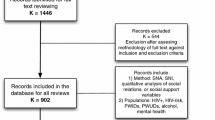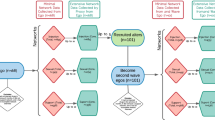Abstract
The study compared social support networks of HIV seropositive versus seronegative injection drug users (IDUs). Participants were 635 low income African Americans; 47% were HIV seropositive (of whom 17% had AIDS), 45% female, and 45% current drug users. A social network methodology elicited structural, functional, and relational network components. After controlling for confounders, HIV seropositive compared with HIV seronegative IDUs had larger support networks, including more females, kin and sources of instrumental assistance, and marginally more sources of emotional support, though they were less likely to have a sex partner. There was no difference between HIV status and number of active drug users in support networks. Results suggest that HIV seropositive IDUs had mobilized a range of network support but that they also relied on drug using social influences. Findings may have implications to the development of integrated HIV prevention and care intervention that builds on HIV seropositives’ natural support structures.
Similar content being viewed by others
References
Barrera, M. A. (1980). A method for assessing social support networks in community survey research. Connections, 3, 8–13.
Burton, L., Kasper, J., Shore, A., Cagney, K., LaVeist, T., Cubbin, C., and German, P. (1995). The structure of informal care: Are there differences by race?Gerontologist, 35, 744–752.
Carrieri, M. P., Chesney, M. A., Spire, B., Loundou, A., Sobel, A., Lepeu, G., and Moatti, J. P. (2003). Failure to maintain adherence to HAART in a cohort of French HIV-positive injecting drug users. International Journal of Behavioral Medicine, 10, 1–14.
Friedman, S. R., Des Jarlais, D. C., and Sterk, C. (1990). AIDS and the social relations of intravenous drug users. Milbank Quarterly, 68(Suppl. 1), 85–110.
Gielen, A. C., McDonnell, K. A., Wu, A. W., O’Campo, P., and Faden, R. (2001). Quality of life among women living with HIV: The importance violence, social support, and self care behaviors. Social Science and Medicine, 52, 315–322.
Grund, J. P., Blanken, P., Adriaans, N. F., Kaplan, C. D., Barendregt, C., and Meeuwsen, M. (1992). Reaching the unreached: Targeting hidden IDU populations with clean needles via known user groups. Journal of Psychoactive Drugs, 24, 41–47.
Heckman, T. G., Kelly, J. A., and Somlai, A. M. (1998). Predictors of continued high-risk sexual behavior in a community sample of persons living with HIV/AIDS. AIDS and Behavior, 2, 127–135.
House, J. S., Kahn, R. L., McLeod, J. D., and Williams, D. (1985). Measures and concepts of social support. In S. Cohen and S. L. Symes (Eds.), Social support and health (pp. 83–108). San Diego, CA: Academic Press.
Johnson, D., Stall, R., and Smith, K. (1995). Reliance by gay men and intravenous drug users on friends and family for AIDS-related care. AIDS Care, 7, 307–319.
Knight, D. K., Broome, K. M., Cross, D. R., and Simpson, D. D. (1998). Antisocial tendency among drug-addicted adults: Potential long-term effects of parental absence, support, and conflict during childhood. American Journal of Drug and Alcohol Abuse, 24, 361–375.
Knowlton, A. R., Hua, W., and Latkin, C. A. (2004). Social support networks and medical service use among HIV positive injection drug users: Implications to intervention. AIDS Care.
Knowlton, A. R., Latkin, C. A., Hoover, D. R., Celentano, D. D., and Ensminger, M. (2000). HIV and depressive symptoms among low income illicit drug users. AIDS and Behavior, 4, 252–360.
Lackner, J., Joseph, J., Ostrow, D., Kessler, R., Eshleman, S., Wortman, C., OBrien, K., Phair, J., and Chimiel, J. (1993). A longitudinal study of psychological distress in a cohort of gay men: Effects of social support and coping strategies. Journal of Nervous and Mental Disorders, 181, 4–12.
Latkin, C., Mandell, W., and Vlahov, D. (1996). The relationship between risk networks’ patterns of crack cocaine and alcohol consumption and HIV-related sexual behaviors among adult injection drug users: A prospective study. Drug and Alcohol Dependence, 42, 175–181.
Latkin, C. A. (1998). Outreach in natural settings: The use of peer leaders for HIV prevention among injecting drug users’ networks. Public Health Reports, 113(Suppl. l), 151–159.
Latkin, C. A., Forman, V., Knowlton, A., and Sherman, S. (2003a). Norms, social networks, and HIV-related risk behaviors among urban disadvantaged drug users. Social Science and Medicine, 56, 465–476.
Latkin, C. A., Knowlton, A. R., Forman, V. L., Hoover, D. R., Schroeder, J. R., Hachey, M., and Celentano, D. D. (2001). Injection drug users’ disclosure of HIV seropositive status to network members. AIDS and Behavior, 5, 297–305.
Latkin, C. A., Knowlton, A. R., Hoover, D., and Mandell, W. (1999). Drug network characteristics as a predictor of cessation of drug use among adult injection drug users: A prospective study. American Journal of Drug and Alcohol Abuse, 25, 463–473.
Latkin, C. A., Sherman, S., and Knowlton, A. (2003b). HIV prevention among drug users: Outcome of a network-oriented peer outreach intervention. Health Psychology, 22, 332–339.
Miller, M., and Neaigus, A. (2002). Sex partner support, drug use and sex risk among HIV-negative non-injecting heroin users. AIDS Care, 14, 801–813.
Murphy, D. A., Greenwell, L., and Hoffman, D. (2002). Factors associated with antiretroviral adherence among HIV-infected women with children. Women’s Health, 36, 97–111.
Neaigus, A., Friedman, S. R., Curtis, R., Des Jarlais, D. C., Furst, R. T., Jose, B., Mota, P., Stepherson, B., Sufian, M., Ward, T., et al. (1994). The relevance of drug injectors’ social and risk networks for understanding and preventing HIV infection. Social Science and Medicine, 38, 67–78.
Rook, K. S., Pietromonaco, P. R., and Lewis, M. A. (1994). When are dysphoric individuals distressing to others and vice versa? Effects of friendship, similarity, and interaction task. Journal of Personality and Social Psychology, 67, 548–559.
Rothenberg, R. B., Potterat, J. J., Woodhouse, D. E., Muth, S. Q., Darrow, W. W., and Klovdahl, A. S. (1998). Social network dynamics and HIV transmission. AIDS, 12, 1529–1536.
Samet, J. H., Freedberg, K. A., Stein, M. D., Lewis, R., Savetsky, J., Sullivan, L., Levenson, S. M., and Hingson, R. (1998). Trillion virion delay: Time from testing positive for HIV to presentation for primary care. Archives of Internal Medicine, 158, 734–740.
Schwarzer, R., Dunkel-Schetter, C., and Kemeny, M. (1994). The multidimensional nature of received social support in gay men at risk of HIV infection and AIDS. American Journal of Community Psychology, 22, 319–339.
Sherman, S., and Latkin, C. (2001). Intimate relationship characteristics associated with condom use among drug users and their sex partners: A multilevel analysis. Drug and Alcohol Dependence, 64, 97–104.
Smith, M. Y., and Rapkin, B. D. (1996). Social support and barriers to family involvement in caregiving for persons with AIDS: Implications for patient education. Patient Education and Counseling, 27, 85–94.
St Clair, P. A., Smeriglio, V. L., Alexander, C. S., and Celentano, D. D. (1989). Social network structure and prenatal care utilization. Medical Care, 27, 823–832.
Tyndall, M. W., Patrick, D., Spittal, P., Li, K., O’Shaughnessy, M. V., and Schechter, M. T. (2002). Risky sexual behaviours among injection drugs users with high HIV prevalence: Implications for STD control. Sexually Transmitted Infections, 78 (Suppl. 1), 170–175.
van der Straten, A., Vernon, K. A., Knight, K. R., Gomez, C. A., and Padian, N. S. (1998). Managing HIV among serodiscordant heterosexual couples: Serostatus, stigma and sex. AIDS Care, 10, 533–548.
Vaux, A. (1988). Social support: Theory, research, and intervention. New York, NY: Praeger.
Vlahov, D., Anthony, J. C., Munoz, A., Margolick, J., Nelson, K. E., Celentano, D. D., Solomon, L., and Polk, B. F. (1991). The ALIVE study, a longitudinal study of HIV-1 infection in intravenous drug users: Description of methods and characteristics of participants. NIDA Research Monograph, 109, 75–100.
Author information
Authors and Affiliations
Corresponding author
Rights and permissions
About this article
Cite this article
Knowlton, A., Hua, W. & Latkin, C. Social Support Among HIV Positive Injection Drug Users: Implications to Integrated Intervention for HIV Positives. AIDS Behav 8, 357–363 (2004). https://doi.org/10.1007/s10461-004-7320-7
Issue Date:
DOI: https://doi.org/10.1007/s10461-004-7320-7




